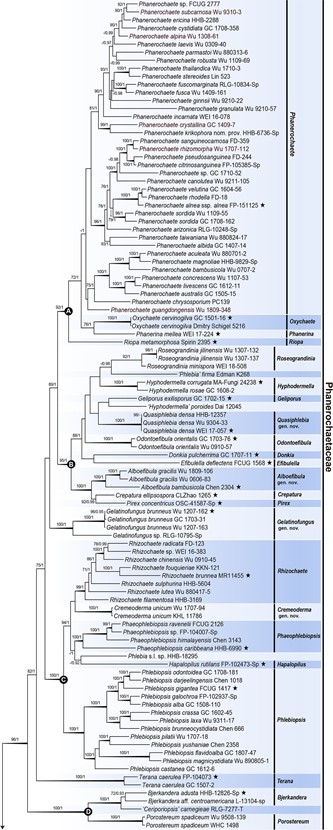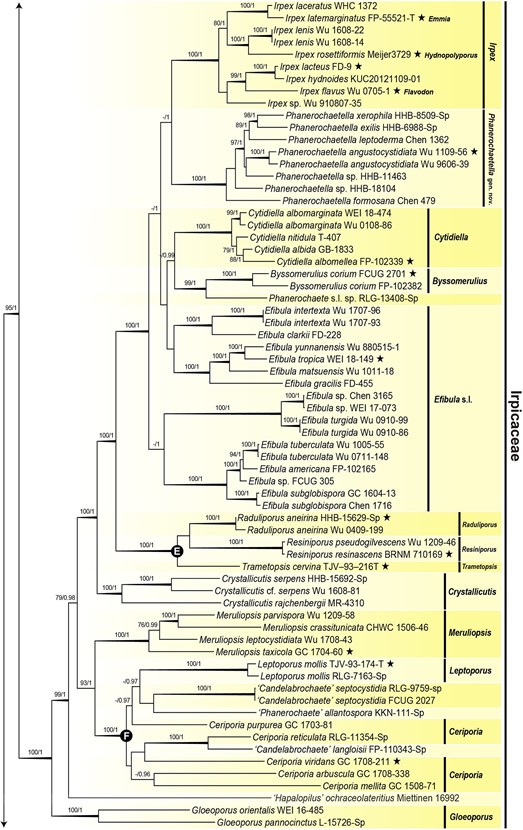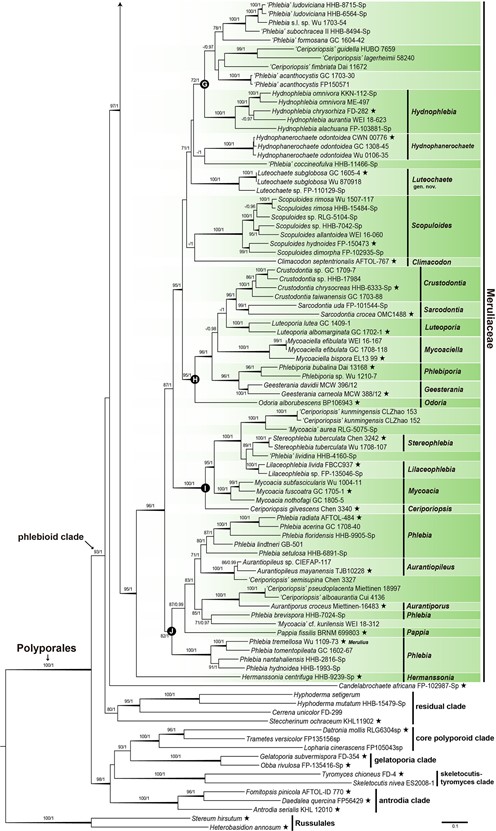Quasiphlebia C.C. Chen & Sheng H. Wu, gen. nov. Fig. 24
MycoBank number: MB 840761; Index Fungorum number: IF 840761; Facesoffungi number: FoF;
Type species: Quasiphlebia densa.
Etymology: From quasi– + –phlebia, referring to the morphological characters similar to the genus Phlebia.
Description: Basidiocarps, effused, adnate, ceraceous. Hymenial surface pinkish-buff, clay-pink or yellowish-brown, not changing in KOH, smooth to tuberculate. Hyphal system monomitic; generative hyphae nodose-septate. Subiculum fairly uniform, with dense texture; hyphae colorless, slightly to distinctly thick-walled, hyphal anastomosis variably present. Cystidia cylindrical, thin-walled. Basidia clavate to narrowly clavate, thin-walled, 4-sterigmate. Basidiospores ellipsoid, colorless, thin-walled, smooth, inamyloid, nondextrinoid, acyanophilous. Causing a white rot on angiosperm wood.
Notes: – The monotypic genus Quasiphlebia is characterized by effused basidiocarps with smooth to tuberculate or reticulate hymenophore, a monomitic hyphal system with clamped hyphae, thick-walled subicular hyphae, ellipsoid basidiospores, clavate to narrowly clavate basidia, and the presence of leptocystidia. Quasiphlebia resembles Phlebia s.l. by having agglutinated, dense subiculum, and a monomitic hyphal system with clamped hyphae, and clavate to narrowly clavate basidia. However, hymenophores of Phlebia s.s. are usually merulioid, folded, or odontioid. The present phylogenetic analyses placed Quasiphlebia in the Donkia lineage of Phanerochaetaceae, whereas Phlebia is in the Meruliaceae (Fig. 1). Quasiphlebia is also similar to Flavophlebia (Parmasto) K.H. Larss. & Hjortstam, which bears subglobose basidiospores with oily contents (Bernicchia and Gorjón 2010).

Fig. 1 The phylogram of the phlebioid clade (Phanerochaetaceae, Irpicaceae, Meruliaceae) of Polyporales inferred from ML analyses using the combined ITS + 28S + rpb1 + rpb2 + tef1 dataset. Branches are labelled with ML BS ≥ 70% and PP ≥ 0.9 from Bayesian analyses. Thicken branches indicated both ML BS ≥ 95% and PP ≥ 0.99 from Bayesian analyses. Line- ages labeled A–J represent the Phanerochaete, Donkia, Phlebiopsis, Bjerkandera, Trametopsis, Ceriporia, Hydnophlebia, Sarcodontia, Mycoacia and core Phlebia lineages, respectively. Black stars (★) represent for strains of generic type species. Bar = substitutions per site

Fig. 1 (Continued)

Fig. 1 (Continued)

Fig. 24 Basidiocarps of Quasiphlebia densa (WEI 17-057, holotype) in general and detailed views. Bars = 10 mm
Species
